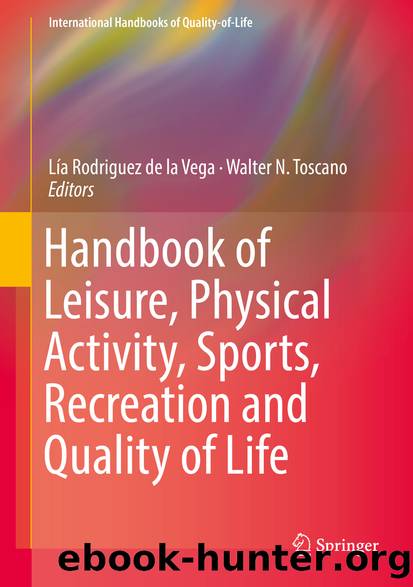Handbook of Leisure, Physical Activity, Sports, Recreation and Quality of Life by Lía Rodriguez de la Vega & Walter N. Toscano

Author:Lía Rodriguez de la Vega & Walter N. Toscano
Language: eng
Format: epub
Publisher: Springer International Publishing, Cham
Later this methodology has been replicated in Velázquez (2008), updated to the 2001 census.
At the same time, the use of this indicator has been common in other geographic studies for minor scales, but whose spatial analysis units were also the provinces, departments, or urban areas. While this has allowed for an approximate knowledge of the territorial distribution of the places where tourist entertainment converges, it is well worth noting that the use of indicators relating to the leisure activities that can be performed on a daily basis or several times a week in the living spaces of subjects were left out of the analysis. No doubt this situation was due to the lack of statistical information on these aspects.
However, once this problem is assimilated, further research indicates that, through subjective evaluation criteria related to the search for information provided by municipalities, the use of satellite images and direct field observation, in recent years the application of indicators that guide in favor of a territorial interpretation of leisure has increased, even though its location within the environmental domain persists and it does not appear as an independent dimension of analysis. In this regard, in Velázquez et al. (2014), the existence of Recreational Resources of Natural Base (RRBN) and Recreational Resources Socially Constructed (RRSC) are proposed as variables of the respective life quality index to the 2010 census. While the first category includes beaches, hot springs, snow used in recreational activities, water bodies and flows, and green spaces; the second distinguishes urban heritage, cultural, sporting and commercial or leisure centers.
In terms of the quality of life indices applied to the city of Mar del Plata, the book about Territory and Quality of Life directed by Lucero et al. (2008) incorporated the Surface in square meters of green space per inhabitant indicator in one of its chapters and, like at the national level, within the environmental dimension. For each census fraction5 that make up the city, Lucero et al. (2008) relate the total number of residents to the area of green spaces such as squares, beaches,6 seaside walks and forest reserves. As a result, and out of the data from the 2001 census, they obtain an average of 14.85 m2 of public green space per inhabitant, a value significantly higher than the 9 m2 recommended by the World Health Organization. Despite this fact, they emphasize that the territorial distribution towards the interior of the city is heterogeneous: coastal census fractions where spacious squares (4 acres) are located in the central area, and those census fractions within garden neighborhoods or forest reserves, coinciding with the more favorable situations. However, in this case, the analysis was limited to a narrated description of the indicator, regardless of its cartographic expression. As a product of their inclusion in the environmental dimension, the observations of the authors point to the importance of these spaces for urban sustainability rather than to their role as leisure spaces.
Nevertheless, in another chapter of the work above mentioned, Rivière (2008) studied the territorial
Download
This site does not store any files on its server. We only index and link to content provided by other sites. Please contact the content providers to delete copyright contents if any and email us, we'll remove relevant links or contents immediately.
Unstoppable by Maria Sharapova(3118)
The Inner Game of Tennis by W. Timothy Gallwey(2990)
Urban Outlaw by Magnus Walker(2950)
Crazy Is My Superpower by A.J. Mendez Brooks(2860)
The Social Psychology of Inequality by Unknown(2309)
The Fight by Norman Mailer(2158)
Unstoppable: My Life So Far by Maria Sharapova(2128)
Going Long by Editors of Runner's World(1920)
Accepted by Pat Patterson(1917)
Motorcycle Man by Kristen Ashley(1860)
The Sports Gene: Inside the Science of Extraordinary Athletic Performance by David Epstein(1821)
The Happy Runner by David Roche(1820)
Backpacker the Complete Guide to Backpacking by Backpacker Magazine(1815)
Sea Survival Handbook by Keith Colwell(1794)
Futebol by Alex Bellos(1784)
Mind Fuck by Manna Francis(1743)
Peak: Secrets from the New Science of Expertise by Anders Ericsson & Robert Pool(1662)
Endure by Alex Hutchinson(1605)
The Call of Everest by Conrad Anker(1550)
